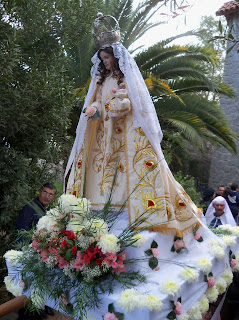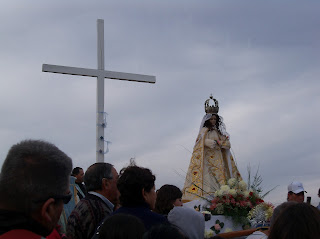So. Chile!
The flight left when they said it would – actually, a little
before! – and I got to snooze a bit, which was good, and woke up just in time
to see the slow approach and appreciate the view of the crossing of the mighty
Andes. Aconcagua, as I think it’s called, the highest mountain in the Andes,
was to the right of the plane; my view was out the left side. But I am not
complaining. It was really fun to watch the landscape roll past – snow-swept,
jagged peaks (not, I think importantly, snow-covered), barren valleys between…It was amazing how the
towns just, plain, stopped at the feet of the Andes. A clear, easy-to-read line.
“Above here, there’s just no way.”
About three minutes of unpleasantness in the middle of the
range – as the pilot assured us in a perfectly calm voice when it was all over,
“Just a bit of turbulence; quite normal over the Andes in the winter. Happens
every time, almost – sorry about that.” But before that? Those were some
harrowing moments. First time I’ve been on an airplane, I think, and
heard people out-and-out scream. Rough, rough going there. Nobody hit the
ceiling, which I understand does occasionally happen on trips that people
survive. But I will have no more of that, thank you very much.
Landed in Chile and made it through customs, and found Don
and his friend Juan Pablo on the other side. Juan Pablo is the 22-year-old
grandson of a man who received his land in the land reform that was initiated
by Salvador Allende, and then continued, surprisingly, by Pinochet after the
coup. He’s split the land now among his sons, and they all live along the same
road, each working a slice of the land, which is irrigated by an acequia, an eighteen-inch-wide, almost-perfectly maintained
channel that burbles along happily behind the row of houses.
But before we got there, we drove a bit over an hour, out of
Santiago (the portion I saw rivals Montevideo in quality of roads and
cleanliness of aspect), through a two-kilometer-long tunnel, and into the
valley where Don and Bridget have been living with Juan Pablo and his family.
The countryside, I should say, is lush and green compared to
Uruguay this time of year. They pretty much don’t get rain except for the
winter, which is now; when there’s so little, and the rivers, fed by the snow
in the Andes, are so dependable, you learn to irrigate, and once you’ve done
that, you can plant and harvest year-round. I passed so many acres of grape
plantations – and learned that table grapes are planted in a roof-like pattern,
with the stems running up posts and then along lattices that overhang the whole
field. Wine grapes, whose form and flesh are less important to their final
state, grow along horizontal, fence-like wires.
There was no doubt that I was back in the Andes. Just
something about everything, practically – the steep, crumbly mountains all
around that manage somehow not to come sliding down, despite their sparse
vegetation; the frequency and stony quality of the little rivers one
crosses…Any number of things – the smell in the air, somehow.
Our first stop was a town – I forget its name – where they
were doing a procesión with their local
church’s statue of Mary. She left the church and went to the top of a hill,
where I think there’s a cross (we didn’t go up; Don, who lived in this town as
a volunteer years ago, was being all but mobbed by people he’d not seen in a
while, and our mobility was limited).
Mary was being carried on a litter by
about eight local men, dressed to the nines, all venerable gray-haired sorts,
and accompanied by “bailes chinos”
– Chinese dances. These were two columns of men (and women, which surprised me)
dressed in red satin shirts with cris-crossing ribbons of different colors
across their chests, and crown-like head dresses; some of them beat drums, and
some of them played on wheezing, strangely-pitched wooden flutes. They would
alternate: those whose pipes were of one particular note would blow first, and
then those carrying pipes whose pitch was just different enough to raise the
hairs on the back of your neck and make you feel instant angst.
Don had never
heard such a thing before (these dances had fallen out of common practice when
he’d lived here), and remarked on how disquieting the combination of notes was;
I was reminded of a lot of old, old Andean music I’d heard, with a much more
pentatonic scale to it than Western music, and with occasional arrangements
where it seemed the music was meant to send shivers down your spine and nothing
else. It fits with the aesthetic I’ve seen in Ecuador in person, and from Peru
and Bolivia second-hand: A joyful, even euphoric sadness. Happy, happy tunes
about suicide and disappeared lovers, or wailing dirges like this one, meant to
accompany the Virgin Mary on her happy rounds.
And speaking of Indigenous folks: This is my first time in
Chile, and I didn’t spend any time in the airport. But I did notice, even on
the plane, that your average Chilean seemed to have a different facial make-up
from your average Uruguayan. More broad in the cheekbones, darker of hair,
finer, if broader and perhaps shorter, in build. And when I arrived at Don’s
town and got out of the car, and started to move in a large crowd of locals, it
was confirmed for me: If your “average” Uruguayan (there’s really no such
thing, but as an academic exercise, you know what I mean) is likely to have 8
or 9% Indian features reflected in their face, then the average Chilean, among
those living out where we are, at least, has about 50% Indian features. Some
more, some less, but almost none have no Indian features to them – whereas I
could have snapped a photo of the crowded streets of Montevideo and had a good
chance of being able to convince you it was taken in Italy.
Bridget found me in the crowd and gave me a hug, and I
greeted their daughter, who’s 8, and their son, who’s 6 – and who, in contrast
to when I last saw them, addressed me in confident, fluid Spanish. It was
wonderful to see. She was kind of on her own, moving in and out of the crowd,
watching the proceedings, but their son was all but handcuffed to a buddy from
the school he goes to. He’d found a piece of bamboo or sugarcane and was aiming
it at everything he could see, sprinting from one stop of the Virgin to the
next, while his pal waved a thorn-covered stick. They looked like they were
having a great time.
We had cake and hot chocolate at the church after the
procession ended, and then hitched a ride back to where Don and Bridget are
staying with a local, who took pity on them because their son was complaining
of a stomach ache. And here I met up with Juan Pablo again, who’d given up his
room for me for the length of my stay, and his mother, Lucy, and father,
Wenceslao, my real hosts. We had very nice conversation and a dinner of soup
and pork, and then watched the Olympics and the news while chatting until bed
time.
It’s cold here at night. I can’t say “colder than Uruguay”,
because I never spent a night in Uruguay in an unheated building, unlike many
of my colleagues. But looking at my bed, next to me here, I count a down
comforter, a sheet, and five, count ‘em, FIVE woolen blankets. So I was fine.
And now Don is out talking on Skype to the apprentice farmer
who’s watching the place for him while he’s here, and the day of relaxed
visiting awaits. I am ready for it.
AND: I had thought, for about 24 hours, that I’d lost my
camera. Then, I found it, packed away in my checked suitcase. I still can’t
think why I would have put it there, but apparently, I did. Menos mal – Going home without it, head hanging, and walking
into the kitchen to face Janneke and her rolling pin…? Not something I was
looking forward to.
A side note: All the engineers involved in constructing sidewalks in Uruguay need to take in some workshops in Chile. These are some damn fine sidewalks: Thick, burly, impervious, and yet still covered over in that attractive and kind-to-the-foot tiling. Larger, red, more attractive tiling. But good, solid, flat sidewalks. If sidewalks are a measure of human development, then Chile is kicking Uruguay's heinie.
A side note: All the engineers involved in constructing sidewalks in Uruguay need to take in some workshops in Chile. These are some damn fine sidewalks: Thick, burly, impervious, and yet still covered over in that attractive and kind-to-the-foot tiling. Larger, red, more attractive tiling. But good, solid, flat sidewalks. If sidewalks are a measure of human development, then Chile is kicking Uruguay's heinie.
(All photos, by the way, complements of Bridgett, who was kind enough to give me copies of her pics from the procession!)




No comments:
Post a Comment